
DonCorson
[AHCI]
3358

Making a 1 Second Pendulum Clock (3D printed)
Pendulum clocks are fascinating me these days. And of course different ways of making them. Having recently acquired a 3D FDM printer I decided to see how (if) one could make a precision clock using this means of production. As I already had a mechanical design for a clock with a Graham escapement that I had planned to make traditionally in brass this was a great starting point for an interesting summer project. As the summer is now long over and my project is completed here is a little report.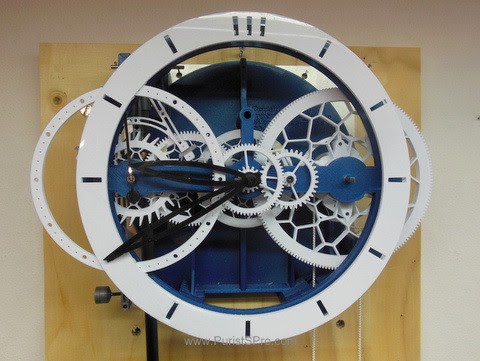
As I explained in some earlier posts there was quite a bit of modification necessary to take a traditional clock construction valid for 3D printing including knowing (and also discovering) where 3D printing was not up to the task. Remember that the goal is to make a precision clock, not a toy such as the many found on Thingiverse and the other sites for sharing 3D designs. Those typical specifications are often something like: running time 20 minutes, error during this running time several minutes. My clock should be capable of at least better timing than a wrist watch, aiming for less than one second a day. To this end I decided to use a 1 second pendulum with a steel suspension spring and a carbon fiber rod. More to this as we get along. Let's start with the movement.
As I mentioned in one of my previous posts I was not able to print gears with 0.5mm module with my 3D printer. So the first thing was to increase the size of the clock to allow gears with 0.8mm module. This makes for a stately clock. In the following we see most of the pieces of the clock movement on the work bench ready for assembly. This picture shows about a weeks worth of work for the 3D printer.

Here the Graham escapement parts, escape wheel, anchor and palettes. The escape pinion with its steel axle and the top of the crutch with its axle. I initially tried to make all the bearings simply steel on printed plastic, but this didn't work at all, too much friction. So I added ball bearings on the axles as many modern clockmakers use these days. The crutch has bronze bushings as it does not turn completely, but just rocks back and forth with the pendulum. This rocking motion is not good for ball bearings resulting in fast wear, simple bushings work better. The escape wheel has 30 teeth turning once a minute, its axle also turning the seconds hand.
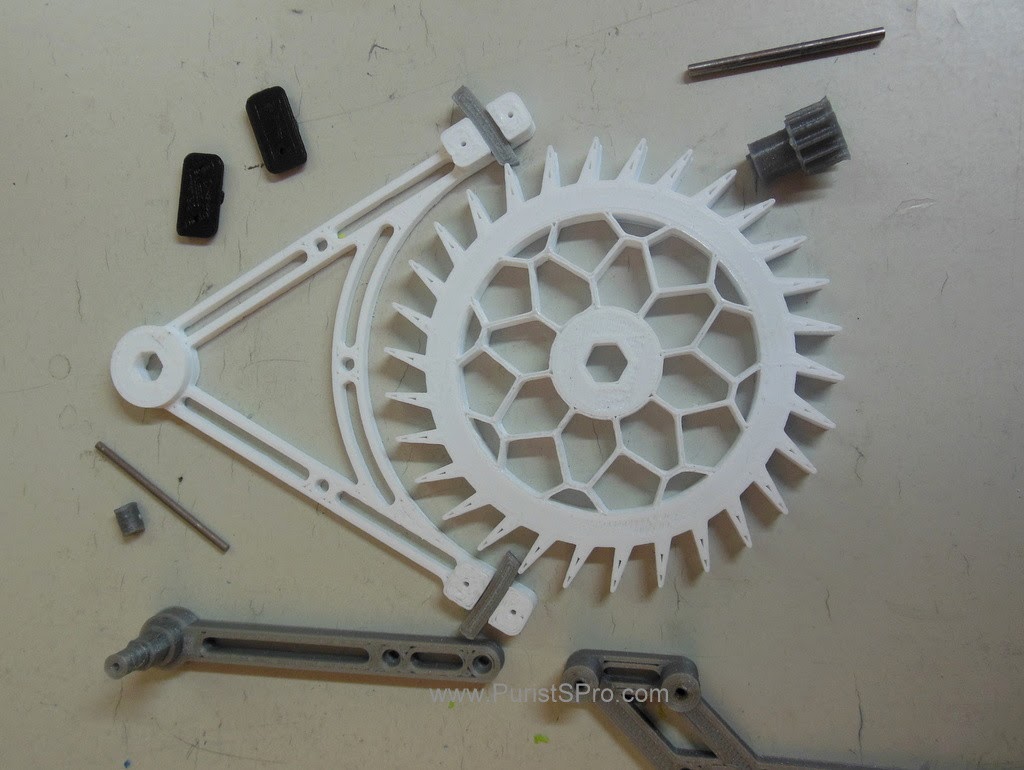
As we move down the gear train we see the 3rd wheel with it's pinion and axle and the minute wheel also with pinion and axle. As the name says the minute wheel turns with the minute hand, once an hour.

Driving the minute wheel is the great wheel which runs on the axle of the barrel. The 13 turns of cord on the barrel make for a clock that only needs to be wound once every 8 days. We see here also the ratchet mechanism between the barrel and the great wheel to allow winding.
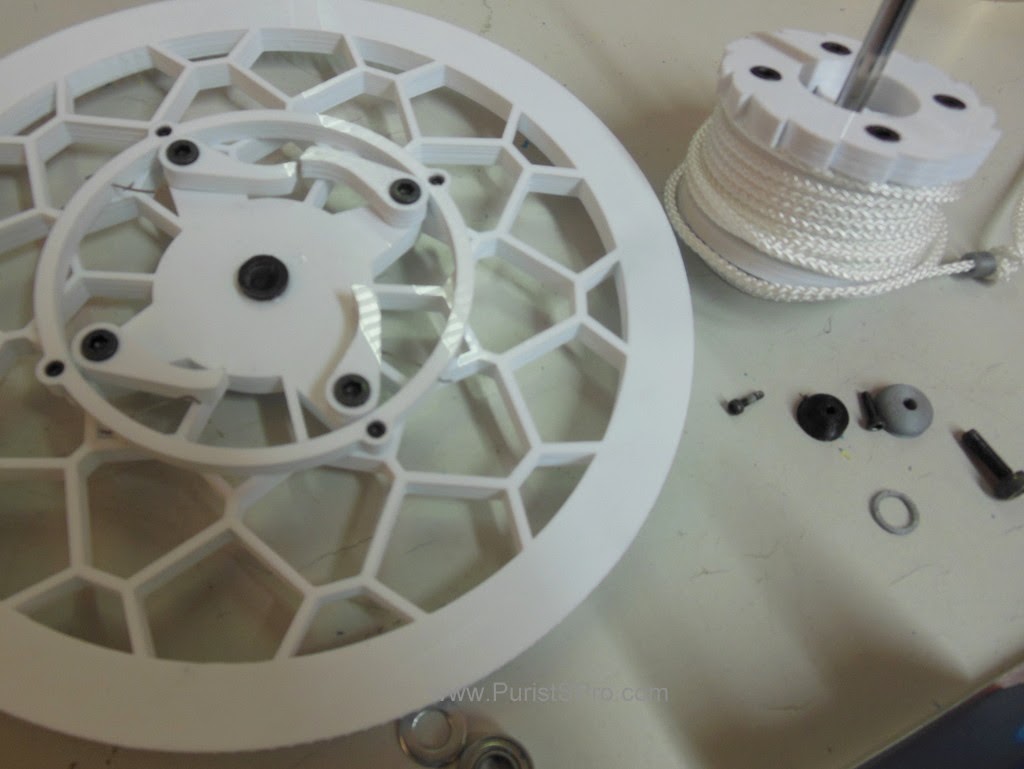
The clock has two bridges, the main bridge holding the second bearing for all the wheels and the escape bridge, the escape wheel being between the escape bridge and the main bridge. Here we also see the hands.

The main plate holds the back bearings and the pendulum support along with the support for the driving weight.
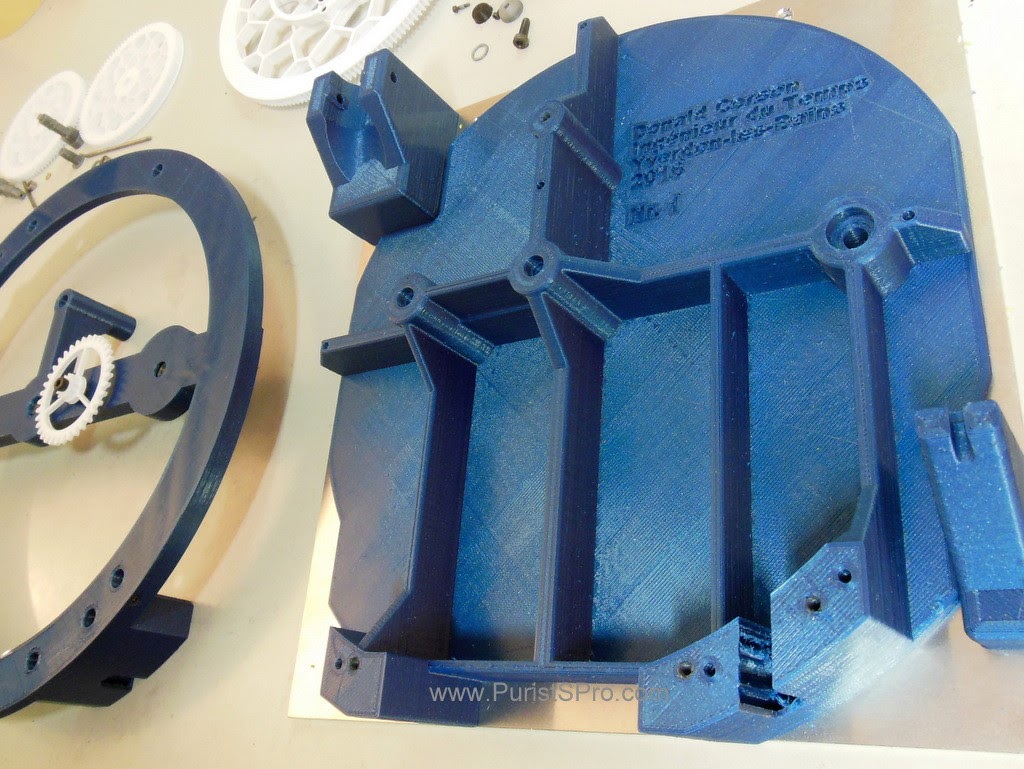
The ratchet teeth in place, the cord wound neatly and the back ball bearing on the axle.

The first part is mounted on the plate.


The minute wheel pinion. As I can't rivet the plastic wheels on the axles I have made hexagonal faces on the wheels and pinions to carry the driving forces.

As plastic doesn't have the resistance of brass I have strengthened the teeth of the gears by two means. First, the gears are several times thicker than I would make them in brass. Second, for the great and minute wheels I have added a flange that supports one side of the teeth through their entire height. In this picture we can see this flange on both the wheel and the pinion.

The third wheel ready for mounting.

The escape wheel is mounted between the main bridge and the escape bridge.
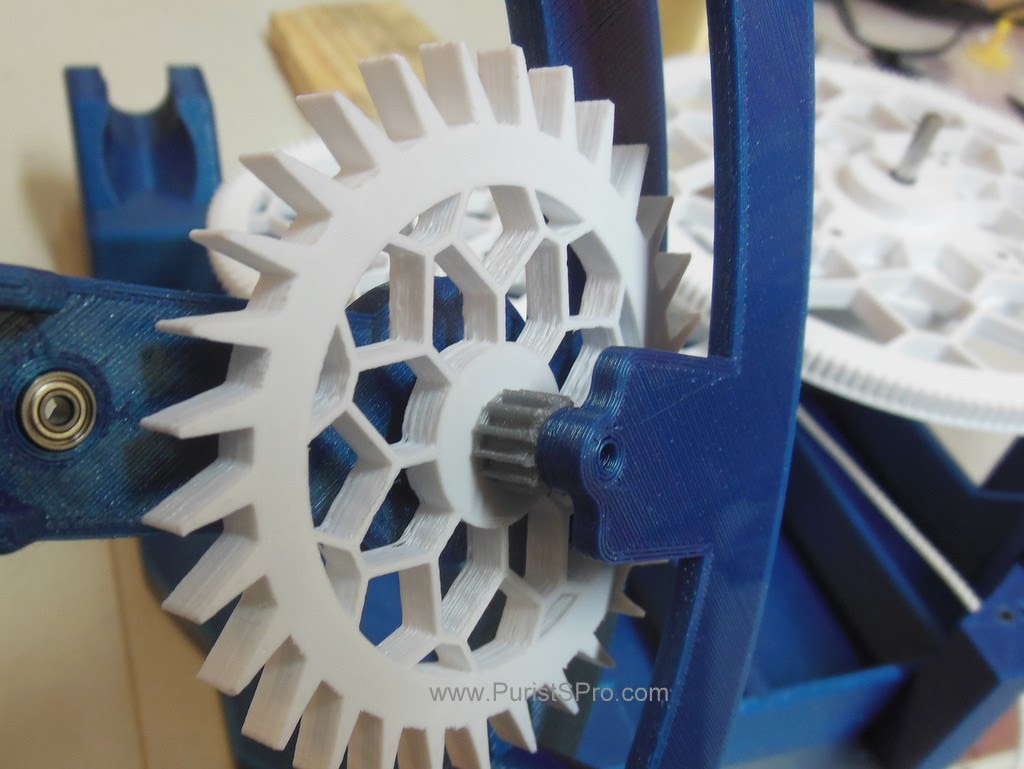
First tests of the gear train without the escapement.
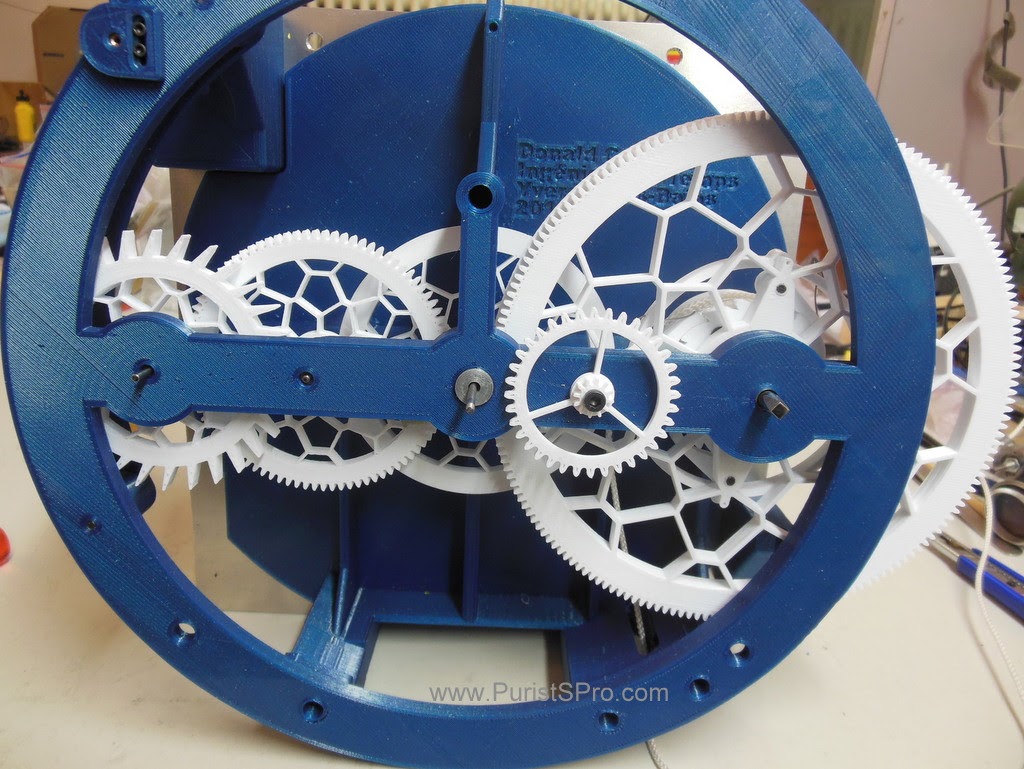
The anchor with the asymmetric crutch. The palettes are a press fit in the anchor and will be finally fixed with palette covers when the escapement has been adjusted.

The anchor is also mounted between the main bridge and the escape bridge as is the escape wheel.

The adjustments of the anchor distance from the escape wheel and the palette positions are fastidious, but not difficult.


The minute and hour hands mounted with their corresponding wheels.



For good timekeeping one needs a constant flow of energy, guaranteed by the gear train, a good escapement and a well made pendulum. My pendulum is made of a carbon fiber rod, a steel suspension spring and a brass bob. Carbon fiber has the advantage of not only being very strong, not really necessary in this application, but also of having a thermal expansion coefficient of nearly zero. As such the timekeeping is hardly effected by temperature changes. The epoxy matrix holding the carbon fibers together is effected by humidity some. I will see with time how much humidity changes really effect the rate of the clock. I have made the bob as a brass ring with the rate adjustment mechanism in the middle. Drilling the hole for the pendulum rod in the bob on the lathe.

The rate adjustment is by a screw in the end of the pendulum rod. Here I am drilling the hole for the adjustment threads in a brass plug. This will be epoxied in the end of the pendulum rod.

The pieces of the rate adjustment mechanism. The large diameter 3D printed disk will allow fine adjustments and is kept out of the timekeeping calculations by supporting the bob by the brass disk blocked with an M3 nut and not on the 3D disk itself.
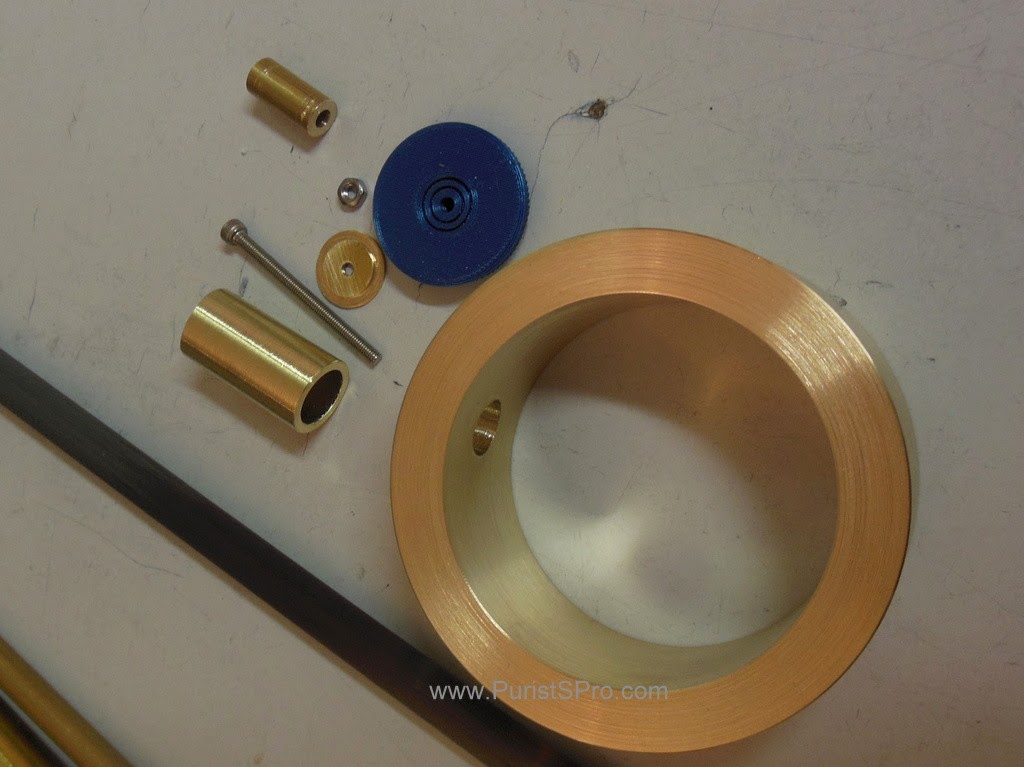
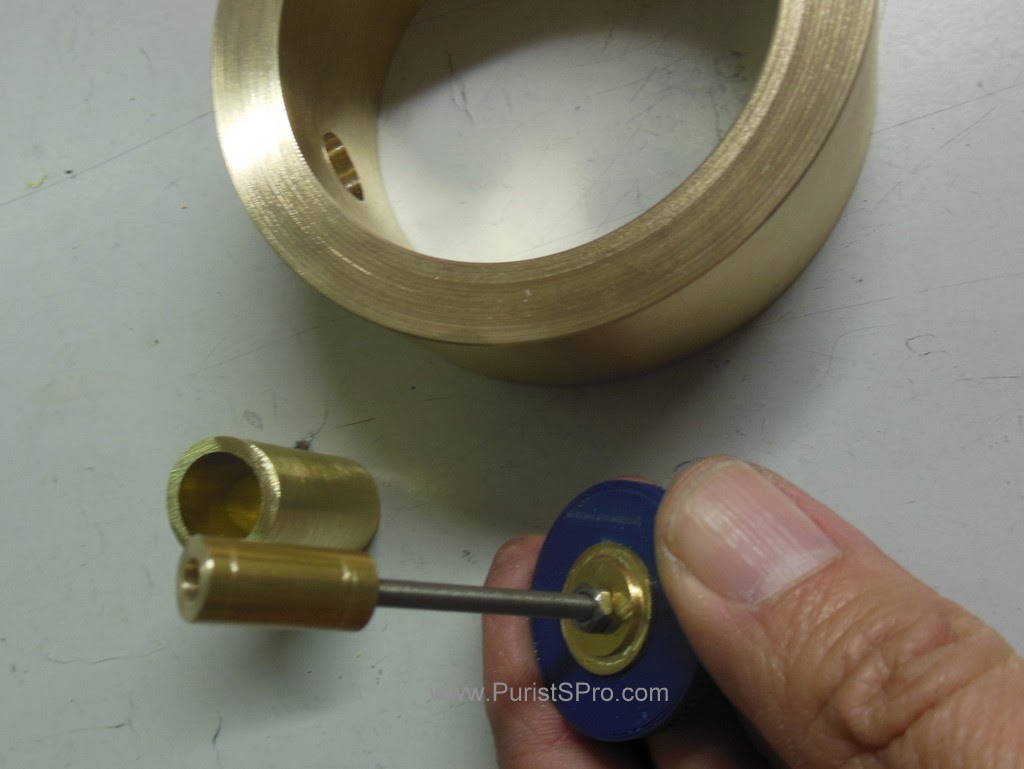
Assembled the bob and rate adjustment mechanism looks like this.


At the top end of the pendulum rod is the suspension, another key component for achieving good timekeeping. The suspension support is a massive 3D printed piece, the upper and lower end pieces for the suspension spring are brass internally with 3D printed guide pieces. The critical jaws clamping the suspension spring and the attachment to the support are brass, thus assuring good mechanical stability. In the picture we can see the brass jaws that internally continue to the pins fixing the suspension to the support and to the pendulum rod. The 3D printed pieces are in this case just guides and to not do any of the critical work.

The pendulum support in place.

The weight powering the clock is a simple steel cylinder with a relatively massive 3D printed pulley.

The clock has been running in my shop now for more than 2 months and I don't see any nascent signs of wear. Now the only work that remains is to get the necessary permission to move the clock from my clock testing board to a wall in our living room and hope that we will enjoy this clock for many years to come.




